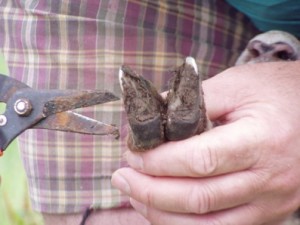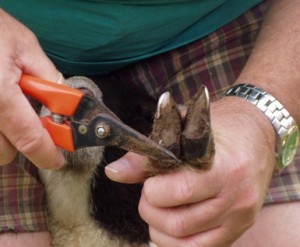 As Aunt Toby said before, there are a couple of items in terms of raising sheep that if you get them right, everything else pretty much falls into place. One of the most important is keeping hooves trimmed. Years ago, I attended a talk by a ruminant specialist from Cornell, who had done a lot of work in Scotland. She said the greatest promoter of sheep health in the Highlands was…the ATV. With an ATV, shepherds could get out to even the most remote, marshy, inhospitable areas where they sheep were holed up (sheep always look for the most remote, marshy and inhospitable places to park themselves; it’s part of their mouflon heritage) to check them, check their feet, do trimming and so on. She was a huge promoter of hoof trimming.
As Aunt Toby said before, there are a couple of items in terms of raising sheep that if you get them right, everything else pretty much falls into place. One of the most important is keeping hooves trimmed. Years ago, I attended a talk by a ruminant specialist from Cornell, who had done a lot of work in Scotland. She said the greatest promoter of sheep health in the Highlands was…the ATV. With an ATV, shepherds could get out to even the most remote, marshy, inhospitable areas where they sheep were holed up (sheep always look for the most remote, marshy and inhospitable places to park themselves; it’s part of their mouflon heritage) to check them, check their feet, do trimming and so on. She was a huge promoter of hoof trimming.
And well she should be. A sheep with overgrown hooves is a sheep in pain (think you in Jimmy Choos that are two sizes too small). It is also a sheep that very probably has developed disease in the hoof itself, another source of misery for the animal. The outside layer (think the fingernails on your hands) grows no matter what. If a sheep is in dry rocky country (like Rocky Mountain sheep territory), then that horny layer gets worn away and keeps in natural trim. If they are not, then that layer will just keep growing and will curve under and basically trap muck, manure, and goodness knows what else between it and the softer underside (see photo – the part of the hoof in the center is like the undersides of the tips of your fingers only a bit tougher). It becomes very painful for the sheep to walk. A sheep that can’t walk is a sheep that can’t graze. You will even see sheep with overgrown hooves on their knees – and what they are praying for is a shepherd to come along and trim up their hooves!
So, this weekend, because a) I needed something for the blog and b) I’m a real nut about keeping the hooves on sheep checked, the DH and The Boy and I went out, corralled the four lambs we are raising in the shed and checked and trimmed their hooves. As you can see from these photos, these guys are not in bad shape – we probably could have allowed them to go another several weeks or a month. But better to get them checked right now. As you can see from the photographs, a sheep’s hoof (like all other ruminants) has two toes, which are both rather teardrop shaped, with the nail layer at the outside wrapped around the more rubbery inner pad.
To check and trim hooves, you need two things for sure, plus one which is nice to have but we never seem to use it.
Absolutely necessary: Hoof clippers (or a hoof knife – hoof clippers seem to give you more control in terms of how much you trim off – and it’s also less likely that you will cut yourself on the upstroke). And, a bottle of disinfectant. We use plain label 10% provodine iodine solution.
The nice thing to have is called a ‘hoof plane’ and looks like a small, 6” wood workers plane with a cheese grater bottom. These work really well if the hooves are really dry and hard – if you can’t trim them easily, you can literally plane them down. You can also use these to get the proper angle on the hoof – you will want the bottom of the hoof at the end to be parallel to the growth lines that you can see around the nail portion of thehoof on the outside; you are not trying to give the goat a set of wedges to walk on (that’s tough on the rest of their legs) .
Some other things to have around as ‘just in case’ – A bucket of hot water with a little bleach/soap in it (if the sheep’s hooves are really mucky – it helps to have something cleaner so that you can see what is going on before you start to trim), paper towels, duct tape, a couple of clean sanitary napkins (in case you trim off too much and the hoof is bleeding, disinfect the hoof area, put on half a sanitary napkin over the bottom of the hoof and wrap with duct tape, forming a boot. If it doesn’t fall off on its own in a day, take it off) and ground or powdered lime. If you have a lot of muck around and the entrances to the barn area are wet, put down a lot of lime (the floor should look actually white). First, it will absorb a lot of the moisture and firm up the ground, which is better for their hooves, and second, it is also a great protector for the animals when it’s on the floor of the barn. Of course, cleaning up the barn floors is your first line of defense in this.
OK – how much should you trim off? Well, the doctor from Cornell was pretty Draconian – as I recall, she shocked the entire room with her answer of “Keep cutting until the hoof starts to bleed – then you know you’ve gotten everything.” Well, if the animal has ‘hoof rot’ or ‘foot scald’ (which are infections caused by the interaction of several anaerobic bacteria and more information can be found hoof rot ), the animal is already miserable and lame. In order to really treat the animal, you have to get beyond the mess to good solid material in order to give the sheep or goat a shot at healing up. If the hooves are not too overgrown, a simple cleaning out of any manure or dirt (especially between the toes) and trimming up with a little squirt of disinfectant if you get too far in should really be enough. One way to become familiar and comfortable doing this, frankly, is to get involved with your local 4H sheep or goat group or find a small sheep raiser, and learn how to do it properly and get some practice. Part of the trick is getting the sheep on his or her rear end (then they are sort of helpless and you can work on them without too much struggle), but learning how to be brave with the clippers is important too.
So, let’s go back to the photograph at the top. What’s going on with this hoof? As you can see, there is not a lot of muck packed in between the toes (actually the DH had already checked that area; if there had been anything, he’d have cleaned that out). If there is stuff in the slot between the toes, you want to get that out because it puts horizontal pressure between the toes. Not good. There is a little bit of overgrowth on one side of one of the toes; the other sides just need a little bit of a trim. The pad areas in the back are pretty good; they just need a little bit of trimming also. This is a very simple job – and actually is the sort of trimming chore that a shepherd wants to see because it means that the general health of the hoof is good.
 Things to look for that mean trouble (besides sheep that are limping) and you have to really trim hooves to heal them up:
Things to look for that mean trouble (besides sheep that are limping) and you have to really trim hooves to heal them up:
1) Really funky odor. I realize that faced with manure on the hoof, you’d think – how funky does she mean? If the animal has a bacterial infection in the hoof, it’s an entirely different smell.
2) Mushiness in either the nail area or the inner layer.
3) Cracks in the nail wall
4) The rubbery inner pad should go all the way across and the nail layer should lay right against it. If there are any pockets between (you’ll be able to tell because there will be dirt there), dunk the hoof in water so that you can see things more clearly and clean any pockets out and trim the nail layer down to them to open them up. The hoof will grow down properly. Pockets promote infections – open them up.
5) Anything that looks like it has pus or other material coming out of it, or is draining.
6) Anything that impedes your view of the inside rubbery layer of the hoof – that’s overgrowth and it’s got to go.
I realize that there is a good bit of the ‘ick’ factor in this discussion – don’t let this put you off from raising sheep or goats if you want to. Once you get the hang of this, it goes quite quickly to do it and it’s something that you can put on the calendar and take care of on a regular basis. Along with keeping the barn floors dry (use that lime) and the barnyard firm (ditto), hoof trimming will keep your sheep on their feet and out in the pasture transforming grass into wool and lamb.
Which is what you want, right?
